Book 4. Liquidity and Treasury Risk
FRM Part 2
LTR 10. Liquidity Stress Testing and Risk Reporting

Presented by: Sudhanshu
Module 1. Liquidity Risk Reports
Module 2. Liquidity Stress Tests
Module 1. Liquidity Risk Reports

Topic 1. Best Practices in Liquidity Reporting
Topic 2. Interpreting Liquidity Risk Reports
Topic 3. Deposit Tracker Report
Topic 4. Daily Liquidity Report
Topic 5. Funding Maturity Gap (Mismatch Report)
Topic 6. Funding Concentration Report
Topic 7. Undrawn Commitment Report
Topic 8. Liability Profile
Topic 9. Wholesale Pricing and Volume
Topic 10. Summary Liquidity Report MI









Topic 1. Best Practices in Liquidity Reporting
-
Best Practices in Liquidity Reporting
-
The management information (MI) liquidity reporting process is mandated by regulatory authorities who determine the frequency and content of the reports.
-
The Asset-Liability Committee (ALCO) is the bank's leadership team responsible for overseeing liquidity risk.
-
Best practices for liquidity reporting, as exemplified by the UK's Financial Services Authority (FSA), include specific reports and frequencies. Other countries have similar requirements.
-
-
Best Practices for Specific Items
-
Nonmaturity Items: Regulators typically treat callable and demand deposits as having a one-day tenor. However, some behavioral adjustments may be allowed for stable retail deposits, such as qualifying up to 50% for a longer maturity.
-
-
Off-Balance-Sheet Items:
-
Derivatives are generally not included in liquidity ratio calculations, with the exception of coupons receivable or payable on their pay dates.
-
Undrawn commitment exposure is included as a cash outflow and is part of liquidity ratio calculations.
-
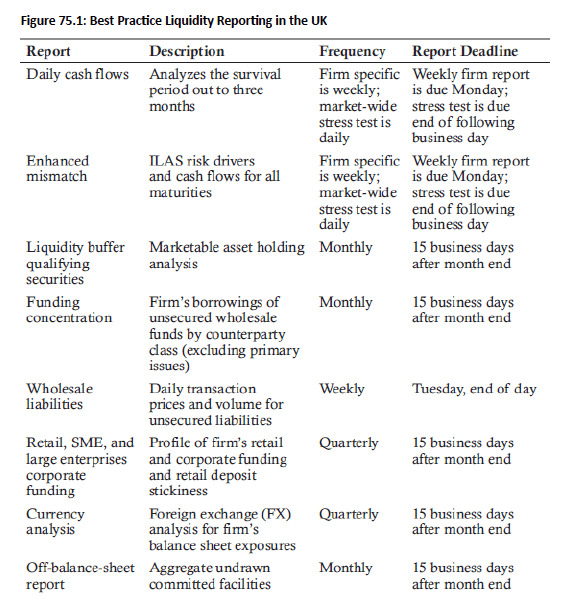
Practice Questions: Q1
Q1. The treatment of tenor for certain types of cash flows for liquidity reporting is a concern for senior managers preparing reports for the Financial Services Authority (FSA) in the United Kingdom (UK). Based on recommendations of the FSA, what should be the treatment in liquidity reports for callable or demand deposits that have no maturity date?
A. 1 day.
B. 1 week.
C. 1 month.
D. 1 year.
Practice Questions: Q1 Answer
Explanation: A is correct.
The FSA in the UK recommends that callable and demand deposits are treated as 1-day tenor by regulators.
Topic 2. Interpreting Liquidity Risk Reports
-
Liquidity reports are generated daily, weekly, monthly, and quarterly, and include both quantitative and qualitative measures.
-
The reports are used for analyzing a bank's liquidity position and are often benchmarks for regulated banks.
-
Key reports include
-
Deposit tracker report
-
Daily liquidity report
-
Funding maturity gap (mismatch) report
-
Funding concentration report
-
Undrawn commitment report
-
Liability profile
-
Wholesale pricing and volume
-
Topic 3. Deposit Tracker Report
-
Summarizes current and forecasted deposit sizes and is generated weekly and monthly.
-
Provides information for calculating the loans-to-deposit (LTD) ratio, a key liquidity metric for bank management.
-
The report can be used to see if the LTD ratio is within the board's target limits.
-
Another section of the report shows the necessary increase in liabilities or decrease in assets to meet target LTD ratios.
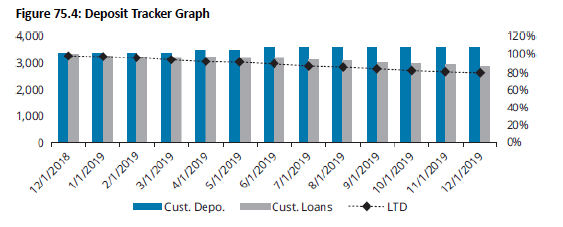
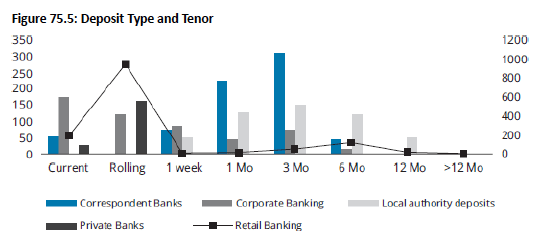
Topic 4. Daily Liquidity Report
-
This report is created using the bank's balance sheet and summarizes the bank's liquid assets, liabilities by maturity, and cumulative liquidity position.
-
The report details liquid assets (marketable securities), nonmarketable certificates of deposit (CDs), and non-ECB eligible securities by tenor.
-
It also summarizes the cumulative cash gap, counterbalancing capacity, and liquidity gap.
-
The liquidity gap is calculated as the cumulative cash gap (inflows minus outflows) minus the counterbalancing capacity (available securities for liquidation).
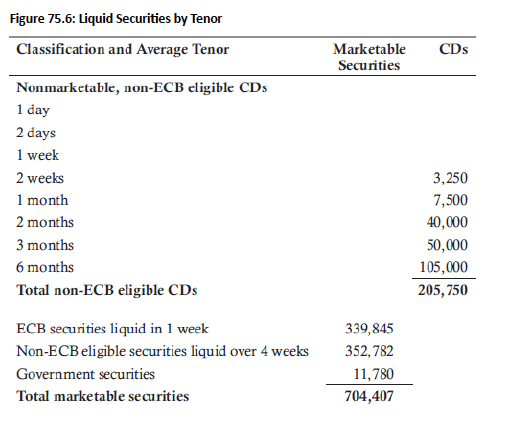
Topic 5. Funding Maturity Gap (Mismatch) Report
-
The mismatch report shows the timing mismatch of all assets and liabilities across various time buckets.
-
It is used to create the cash flow survival report, which tracks the bank's ability to meet the Basel III 30-day survival horizon requirement.
-
The cash flow survival report illustrates cumulative cash flow with and without adjustments for marketable securities.
-
A bank meets the Basel III requirement if it can withstand a 30-day stress period based on its cumulative cash flows after adjustments.
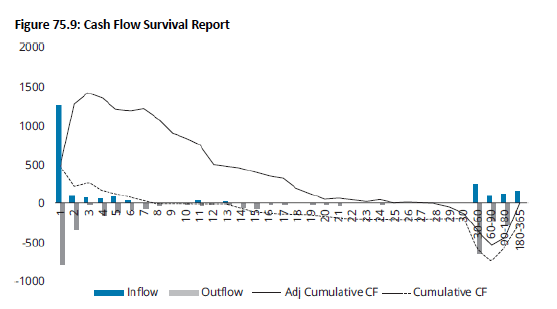
Practice Questions: Q2
Q2. The management of a large national bank creates several reports to track progress in meeting Basel III requirements. The following graph is a cash flow survival horizon that was generated from the maturity gap report. Based on this report, which of the following statements best describes the banks progress in meeting Basel III?
A. The bank satisfies Basel III requirements because, after adjustments, cash flow does not fall below $-1,000$, indicating that the survival horizon is met.
B. The bank does not satisfy Basel III requirements because, after adjustments, cash flow falls below -500 , indicating that the survival horizon is not met.
C. The bank satisfies Basel III because cumulative cash flows before adjustments are near zero for a horizon of 60 days.
D. The bank does not satisfy Basel III requirements because cumulative cash flows before and after adjustments have a horizon of less than 30 days.

Practice Questions: Q2 Answer
Explanation: D is correct.
Basel III requires that banks can meet a 30-day stress test in meeting cash flows. The cash flow survival horizon is approximately only 8 days for this bank before adjustments and only 21 days after adjustments.
Topic 6. Funding Concentration Report
-
Senior treasury and relationship managers use this report to track the diversity of deposits and mitigate liquidity risk.
-
A key goal is to avoid over-dependence on a few large depositors or intragroup funds.
-
Large depositors can be defined as those with deposits over a certain absolute amount (e.g., $50 million) or as a percentage of total liabilities (e.g., 5%).
-
ALCO sets a maximum concentration limit for a single source, and this report helps identify any potential breaches of that limit.

Topic 7. Undrawn Commitment Report
-
This report aggregates undrawn committed facilities and is a monthly report with a deadline of 15 business days after month-end.
-
Undrawn commitment exposure is included as a cash outflow and is part of liquidity ratio calculations.

Topic 8. Liability Profile
-
This report analyzes the profile of a firm's retail and corporate funding, as well as the stickiness of retail deposits.
-
It is a quarterly report with a deadline of 15 business days after month-end.

Topic 9. Wholesale Pricing and Volume
-
This report tracks the daily transaction prices and volumes for unsecured liabilities.
-
It is a weekly report with a deadline of end of day on Tuesday.
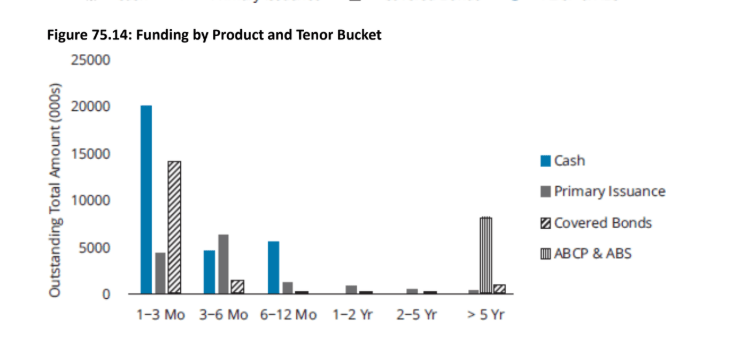

Topic 10. Summary Liquidity Report MI
-
Daily Reports: Daily cash flows and mismatch for market-wide stress tests.
-
Weekly Reports: Daily cash flows and enhanced mismatch (maturity gap) for firm-specific tests, and wholesale liabilities.
-
Monthly Reports: Liquidity buffer, funding concentration, and off-balance sheet reports.
-
Quarterly Reports: Funding and currency analysis.
-
The most important daily reports are the daily liquidity and mismatch reports, which are linked to the survival horizon stress test.

Module 2. Liquidity Stress Tests
Topic 1. Process of reporting a liquidity stress test and liquidity stress test report.

Topic 1. Process of reporting a liquidity stress test and liquidity stress test report.
-
Process of Reporting a Liquidity Stress Test
-
The MI liquidity reporting process is mandated by regulatory authorities who set the frequency and information content of reports.
-
The ALCO is the bank leadership team responsible for overseeing the liquidity risk of the bank.
-
Regulators stipulate requirements for individual liquidity adequacy standards (ILAS) firms.
-
Smaller and foreign subsidiary banks may have firm-specific reporting requirements but are not required to follow the ILAS firm standards.
-
The most important daily reports of daily liquidity and mismatch reports are related to the survival horizon stress test.
-
For the exam, be prepared to interpret specific liquidity reports such as daily liquidity and mismatch, and be prepared to explain the significance of the survival horizon stress test.
-
-
Liquidity Stress Test Report: Survival Horizon
-
The cash flow survival report is used to track the bank's ability to meet the Basel III requirement of a 30-day survival horizon.
-
The dashed line in the report represents cash flow survival under normal circumstances.
-
The solid line represents cash flow survival after marketable securities and other adjustments are made.
-
Basel III requires that banks can withstand a 30-day stress period.
-
Based on the cash survival report in Figure 75.9, a specific bank does not meet the requirements, having only 8 days of cumulative cash flows under normal conditions and 27 days after adjustments.
-

-
Liquidity Reports Related to Stress Testing
-
Daily reports are the daily cash flows and mismatch for market-wide stress tests.
-
Weekly reports include the daily cash flows and enhanced mismatch (maturity gap) for firm-specific tests and the wholesale liability report.
-
The Daily cash flows and Enhanced mismatch reports are two of the most important reports for understanding a bank's liquidity.
-
The Funding maturity gap (mismatch) report shows the mismatch of all assets and liabilities for different time buckets.
-
The mismatch report summarizes the cumulative liquidity cash flow.
-
Net inflows and outflows are adjusted by liquid securities to compute the cumulative mismatch over different time buckets.
-
-
Best Practices in Liquidity Reporting: A conservative approach to the treatment of cash inflows and outflows is recommended for best practices.
- Nonmaturity items: Callable and demand deposits are treated by regulators as having a one-day tenor. Some behavioral adjustments are allowable for stable retail deposits.
- Off-balance-sheet items: Derivatives are not included in liquidity ratio calculations (except for coupons on their pay dates). Undrawn commitment exposure is included as a cash outflow and in liquidity ratio calculations.

Practice Questions: Q1
Q1. One of the most important stress tests for senior bank managers is the cash flow survival report. It is common for banks to forecast two types of cumulative cash inflows and outflows to measure the liquidity risk of the bank. Which of the following best describes the two types of cumulative cash flows, and how often is the report typically run for firm-specific and market-wide stress tests?
A. The two types of cash flows are business as usual and cash flows with adjustments for derivatives and nonmaturing deposits. All stress tests are required weekly.
B. The two types of cash flows are business as usual and cash flows with adjustments for off-balance-sheet items and contingent funding. All stress tests are required daily.
C. The two types of cash flows are business as usual and cash flows with adjustments for retail banking deposits and contingent funding. Firm-specific stress tests are required daily and market-wide stress tests are required weekly.
D. The two types of cash flows are business as usual and cash flows with adjustments for liquidated marketable securities and contingent funding. Firm-specific stress tests are required weekly and market-wide stress tests are required daily.
Practice Questions: Q1 Answer
Explanation: D is correct.
The two types of cash flows are business as usual and cash flows with adjustments for liquidated marketable securities and contingent funding. The Financial Services Authority (FSA) in the UK requires firm-specific stress tests weekly and market-wide stress tests daily.
LTR 10. Liquidity Risk Reporting and Stress Testing
By Prateek Yadav
LTR 10. Liquidity Risk Reporting and Stress Testing
- 80



